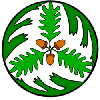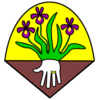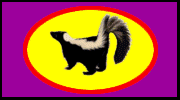
|

|

|
How Colorful is Your Winter Garden?
Winter is normally thought of as a somber season with muted colors and subtle beauty. Georgians are lucky because in addition to the countless evergreens that thrive in our area like the pines, azaleas, boxwood, and junipers, we have pansies that will provide sunny cheerful color right into spring. In addition, we have plants that provide winter interest with colorful berries like nandina, pyracantha, hawthorn, Savannah holly, Burford holly, and Foster holly. Other 'evergreen' plants have foliage that change color to provide contrast for winter, like the fiery red hues of nandina and dwarf nandina, or the plum colors of Andorra juniper, 'Bar Harbor' juniper, and purple wintercreeper euonymus ( Euonymus fortuneii 'Coloratus' and 'Radicans').
A select few plants actually bloom during our winter months. While a few have huge blooms like the camellias, most have smaller blooms that rely on fragrance to get attention. Fortunately this trait makes them ideal plants for bringing cut stems into the house for aroma.
Mahonia, or Oregon grape, is a favorite of mine for its ease of growing in shady areas. Its strong blue-green foliage gives it an appearance of a cross between nandina and a holly. It has fragrant fingers of sunny yellow flowers in January and February that smell of rosewater.
The Camellias are two other shade-loving shrubs with foliage so good you could grow them for their foliage alone. Fortunately the fall-blooming Camellia sasanqua and the winter blooming Camellia japonica have large rose-like flowers in pink, red, and white that encourage use to grow them for their stunning flowers.
Two shade-loving evergreen perennials that bloom in the winter along with the camellias are Helleborus niger, the Christmas rose, and Helleborus orientalis, the lenten rose.
Lonicera fragrantissima, or winter honeysuckle, has the most delicate aroma of the honeysuckles. The plant is a 6-foot tall mounding evergreen that has ordinary looks but a heavenly odor. You can plant it in the backyard and bring in armloads of fragrant branches starting around New Years.
Prunus autumnalis, the autumn cherry, is an unusual tree. Its delicate pink cherry blossoms start opening in the fall and will continue to open on warm winter days. Any flowers that haven't opened in the winter will open in the spring with the other cherries.
Jasminum nudiflorum, or winter jasmine, provides forsythia-like yellow flowers on low cascading mounds a month before the early blooming forsythia. This plant makes a great two foot tall groundcover for banks.
Gelsemiun sempervirens, or. Carolina jessamine, is a native evergreen vine that will bloom in sun or shade. When used on a mailbox, this vine provides color all year with its glossy evergreen foliage and its bright yellow flowers in late winter.
Hamamelis virginiana, the native Witchhazel is a crapemyrtle-sized tree with interesting leaves. The yellow, ribbon-like flowers bloom in November and December. The vernal witchhazel, Hamamelis vernalis, from the Mississippi valley, blooms in January, February, and March. The chinese witchhazel, Hamamelis mollis, blooms in February and March. All the witchhazels enjoy the moist woods and are great additions to a woodland garden. Each of these plants can be limbed up to be grown like a japanese maple.
Other winter blooming shrubs that are less common or are more demanding to grow include:
Chimonanthus praecox, wintersweet
Corylopsis spicata, winterhazel
Daphne odora, winter daphne
Prunus mume, Japanese apricot
Viburnum x bodnantense 'Dawn', Dawn viburnum
These winter blooming shrubs will provide a colorful warmup to the early spring bloomers like flowering quince, bridalwreath spirea, forsythia, purple plum, and Bradford pear.
Many trees and shrubs have bark which contrast beautifully to the stark winter skies. River birch, Betula nigra, and oakleaf hydrangea, Hydrangea quercifolia, have cinnamon bark that peels in sheets, giving an accent in the drabbest months. Sycamore,Platanus occidentalis, and Crapemyrtle, Laegerstroemia indica, have bark that flakes off, leaving interesting patterns of cream, olive, tan, and brown. The American beech, Fagus grandifolia, holds on to its leaves and becomes very noticeable during January and February with its papery tan leaves.
Paul Burns, Garden Design & Education
1996©
 |
Paul Burns Atlanta, Georgia, USA |

Don't Tread on Me! |